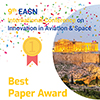
April 27th, 2020
Dr. Yaroslav Dvirnyk, Dr. Dmytro Pavlenko and Dr. Radoslaw Przysowa received the best paper award for their work "Determination of serviceability limits of a turboshaft engine by the criterion of blade natural frequency and stall margin" presented in the 9th EASN International Conference and published in the respective issue of proceedings. The winners share their views on the future of research in the topic of their work in the following interview.
Q1: We would like to congratulate you once again for this outstanding work! Could you please share with us in brief, the scientific and technological significance of this work?
Yaroslav Dvirnyk, Dmytro Pavlenko, Radoslaw Przysowa (all):First of all, we would like to express our deep gratitude for this prestigious award.
It is widely known that helicopters perform crucial tasks for society and the economy. They often operate at a low altitude where their engines are exposed to environmental particles, which adversely affects their performance and operating costs. Although inlet protection systems have been in use since the late 1970s, their effectiveness is often insufficient. That is why engines operated in adverse environments are often grounded and repaired long before they reach their nominal time-between-overhauls (TBO).
To date, the problem of blade erosion has been getting a lot of attention and numerous attempts have been made to describe the intensity of abrasive wear. Developed erosion models can be used to predict the effect of erosion on blade geometry, but structural and CFD analyses are necessary to estimate the maximum permissible wear of blades in a multi-stage axial compressor. We calculated blade vibration and the stall margin of the compressor associated with the loss of the blade profile. Such a science-based framework allowed us to monitor the compressor?s health, predict pre-failure conditions and schedule necessary maintenance. Consequently, this maintains the airworthiness at the required level and facilitates extended operation in a dusty environment.
Q2: Could you please describe the necessary research millstones that need to be achieved on this important topic?
All: The aim of the work was to finetune the serviceability limits of the turboshaft operated in a dusty environment. Our research used fleet data, statistical analysis and numerical modelling (FEM and CFD) to build a digital twin of the axial compressor. That is why we are able to monitor blade erosion, determine the limit state of the compressor and predict the moment when the engine must be grounded. In comparison with the traditional approach, the engine can be operated longer, which significantly reduces maintenance costs.
Necessary research milestones that need to be achieved were as follows:
Q3: You work is related to some important innovative results; in which manner do you expect for these results to have impact to the satisfaction of the European citizens after your research will be completed and the relevant technologies reach the necessary level of maturation?
All:We believe that the air transport of people and goods will become more and more accessible to citizens. New types of vehicles and operational schemes will be introduced, which will involve operating outside airports, e.g. in an urban environment or from unpaved landing sites. Recent modelling and prognostics capabilities, such as digital twins, have to be widely used to ensure safe and cost-effective operations. This paper proposes a number of methods for quantifying the effect of erosion on the operation of axial compressors. On the basis of the obtained results, it is possible to make recommendations to operators and maintenance organizations on the permissible blade wear. This makes it possible to predict the malfunctions of engines and increase their remaining useful life (RUL).
Q4: By concluding this interview, could you please let us know if it was the first time that you attended an EASN Conference? How was the experience? Would you consider attending one of our future events and/or recommend it to your colleagues?
Radoslaw Przysowa: I attended the EASN conference for the first time. It was an invaluable experience for me. I appreciate the strong scientific and technical content and a fresh outlook on aviation. In particular, several up-to-date research topics, such as Industry 4.0, hybrid/electric propulsion and sustainable aviation, were well covered in conference sessions.
I would like to thank our hosts for their hospitality and hard work, which made my stay in Athens enjoyable. It was an opportunity for me to receive, extend my network and meet my peers and EU officials. I am going to participate in future EASN events and recommend it to my colleagues, including researchers from the National University "Zaporizhzhya Polytechnic" and MOTOR SICH JSC, which is a leading manufacturer of aircraft engines and helicopters.